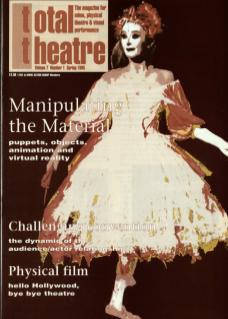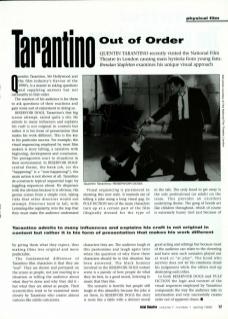Quentin Tarantino, Mr Hollywood and the film industry's flavour of the 1990s, is a master at asking questions and supplying answers but not necessarily in that order.
The reaction of his audience is for them to ask questions of their reactions and gain some sort of enjoyment in doing so.
Reservoir Dogs, Tarantino's first big screen attempt, raised quite a stir. He admits to many influences and explains his craft is not original in content but rather it is his form of presentation that makes his work different. This is the key to his particular success. For example, the visual sequencing employed by most film-makers is storytelling, a narrative with beginning, development and conclusion. The protagonists react to situations in their environment. In Reservoir Dogs' central theme, the bank job (or the ‘happening’) is a ‘non-happening’, the main action is not shown at all. Tarantino deconstructs typical sequential logic by juggling sequences about. He dispenses with the obvious because it is obvious. His genius comes from a simple root, taking risks that other directors would not attempt. Directors tend to fall, with Lemming-like regularity, into the trap that they must make the audience understand by giving them what they expect, thus making films less original and more predictable.
The fundamental difference of Tarantino film characters is that they are ‘real’. They are shown and portrayed on the screen as people, not just reacting to a situation or telling the audience about what they've done and why they did it – but what they are about as people. Their eccentricities tend to be examined more closely by Tarantino who creates almost cartoon-like subtle caricatures.
Visual sequencing is paramount in showing this new style. It reminds me of telling a joke using a long visual gag. In Pulp Fiction two of the main characters turn up at a certain part of the film illogically dressed for the type of characters they are. The audience laugh at this pantomime and laugh again later when the question of why these three characters should be in this situation has been answered. The black humour involved in the Reservoir Dogs torture scene is a parody of how people do what they do best, in a good mood, listening to music that they like.
The scenario is horrific but people still laugh at this absurdity because the joke is on them. In Reservoir Dogs the story is more like a fable with a distinct moral in the tale. The only hood to get away is the sole professional (or adult) on the team. This provides an excellent underlying theme. The gang of hoods act like children throughout, which of course is extremely funny (not just because of good acting and editing) but because most of the audience can relate to the clowning and have seen such scenarios played out at work or ‘at play’. The hood who survives does not let his emotions cloud his judgement while the others end up destroying each other.
In both Reservoir Dogs and Pulp Fiction the logic and content of the visual sequences employed by Tarantino compound the way the audience take in information and very successfully create order out of apparent chaos.
Tarantino admits to many influences and explains his craft is not original in content but rather it is his form of presentation that makes his work different.

